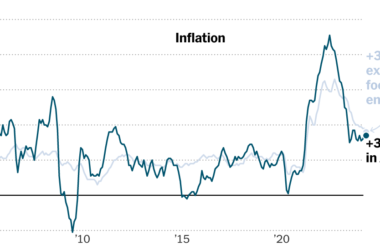The latest analysis of government data shows that the typical American household needs to spend an additional $11,434 annually just to maintain the same standard of living they had in January of 2021, before inflation spiked to 40-year highs. The analysis, conducted by Republican members of the U.S. Senate Joint Economic Committee, uses government data such as the Consumer Price Index and Consumer Expenditure Survey to assess the impact of inflation state by state.
Despite the fact that the U.S. inflation rate is receding and the economy is strong by many measures, many families are still feeling the financial strain. CBS News polling indicates that more people are reporting financial struggles than before the pandemic, with inflation being the main reason for Americans’ pessimism about the economy, despite some positive indicators such as stronger wage gains in recent years.
The Biden administration has criticized the analysis as “flawed,” citing federal labor data that shows a 16% increase in per capita disposable income since December 2020, just before President Joe Biden’s inauguration.
According to a White House spokesman, “14 million more Americans have jobs today than when President Biden took office and household disposable income is up by almost $21,000 since December 2020. And what Congressional Republicans pushing this one-sided study won’t admit is that their proposals would raise costs on the middle class and cut Social Security and Medicare so they can give rich special interests more tax giveaways.”
Economists attribute high inflation to a number of pandemic-related issues rather than decisions from any one political party. For example, spending bills signed by both Presidents Donald Trump and Joe Biden put stimulus money into the hands of millions of Americans, while global supply-chain snarls and labor shortages drove up the cost of goods and services.
Although inflation is now cooling rapidly, many consumers say they aren’t feeling it, with a new Bankrate survey finding that 60% of working Americans say their income has lagged inflation over the past 12 months.
“On the edge”
Average hourly pay for workers has increased by 13.6% since January 2021, although that is lower than the 17% increase in inflation during the same period, according to government data. The main categories requiring heavier spending for consumers simply to maintain their standard of living are food, transportation, housing, and energy, which together account for almost 80 cents of every $1 in additional spending, according to the Republican analysis.
“Middle- and low-income Americans aren’t doing well enough — they are living fragilely on the edge,” said Gene Ludwig, chairman of the Ludwig Institute for Shared Economic Prosperity (LISEP), a think tank whose own analysis found that the income needed to cover the basics fell short by almost $14,000, on average, in 2022.
Where inflation bites hardest
The state with the highest additional expenditures to afford the same standard of living compared with 2021 is Colorado, where a household must spend an extra $15,000 per year, the JEC analysis found. Residents in Arkansas, meanwhile, have to spend the least to maintain their standard of living, at about $8,500 on an annual basis.
The differences in costs are tied to local economic differences. For instance, typical housing in Colorado requires an additional $267 per month compared with January 2021, while other states saw much smaller increases, the analysis found.
Still, a higher cost of living doesn’t necessarily doom people to financial distress. Ludwig’s group recently found that some expensive cities offer the best quality of life for working-class Americans, largely because of the higher incomes that workers can earn in these cities.
Inflation takes a bigger bite out of lower-income households because by necessity they spend a bigger share of their income on basics than higher-income Americans. And until recently, lower- and middle-income workers’ wages weren’t keeping pace with the gains enjoyed by the nation’s top earners.
“Food costs and basic costs are up more than other costs,” Ludwig noted. “Putting on a Thanksgiving dinner costs the same if you’re a lower- or upper-income American, but for a lower-income American it’s a bigger portion of your spending.”
To be sure, inflation is cooling rapidly, with October’s prices rising 3.2% on an annual basis — far lower than the 9.1% pace recorded in June 2022. But pockets of inflation are still hitting consumers, such as at fast-food restaurants like McDonald’s, where Big Macs now cost 10% more than in December 2020.
Although inflation is cooling, many consumers may not be feeling much relief because most prices aren’t declining (One major exception: gas prices, which are notoriously volatile and which have declined about 5% in the past year.) Consumers are still paying more, albeit at a slower pace, on top of the higher prices that were locked in when price hikes surged in 2022 and earlier this year.








